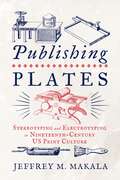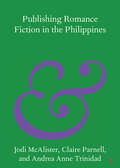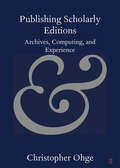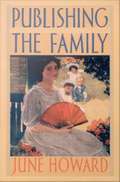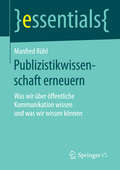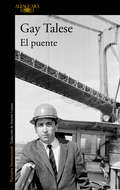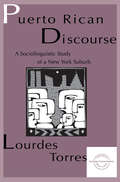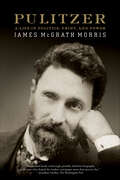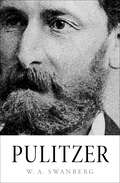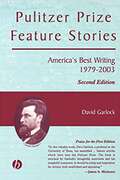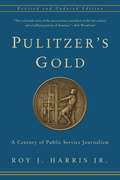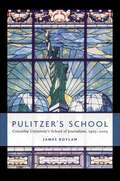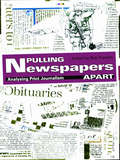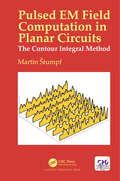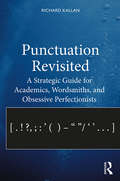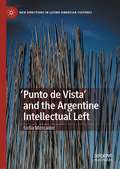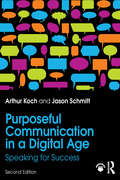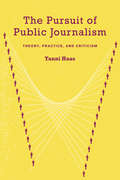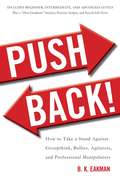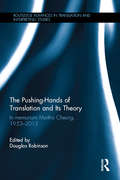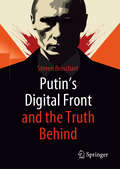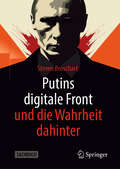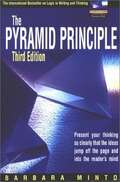- Table View
- List View
Publishing Plates: Stereotyping and Electrotyping in Nineteenth-Century US Print Culture (Penn State Series in the History of the Book)
by Jeffrey M. MakalaFirst realized commercially in the late eighteenth century, stereotyping—the creation of solid printing plates cast from moveable type—fundamentally changed the way in which books were printed. Publishing Plates chronicles the technological and cultural shifts that resulted from the introduction of this technology in the United States.The commissioning of plates altered shop practices, distribution methods, and even the author-publisher relationship. Drawing on archival records, Jeffrey M. Makala traces the first uses of stereotyping in Philadelphia in 1812, its adoption by printers in New York and Philadelphia, and its effects on the trade. He looks closely at the printers, typefounders, authors, and publishers who watched small, regional, artisan-based printing traditions rapidly evolve, clearing the way for the industrialized publishing industry that would emerge in the United States at midcentury. Through case studies of the publisher Mathew Carey and the American Bible Society, one of the first publishers of cheap Bibles, Makala explores the origins of the American publishing industry and American mass media. In addition, Makala examines changes in the notion of authorship, copyright, and language and their effects on writers and literary circles, giving examples from the works and lives of Herman Melville, Sojourner Truth, Edgar Allan Poe, Henry David Thoreau, and Walt Whitman, among others. Incorporating perspectives from the fields of book history, the history of technology, material culture studies, and American studies, this book presents a rich, detailed history of an innovation that transformed American culture.
Publishing Romance Fiction in the Philippines (Elements in Publishing and Book Culture)
by Jodi McAlister Claire Parnell Andrea Anne TrinidadThe romance publishing landscape in the Philippines is vast and complex, characterised by entangled industrial players, diverse kinds of texts, and siloed audiences. This Element maps the large, multilayered, and highly productive sector of the Filipino publishing industry. It explores the distinct genre histories of romance fiction in this territory and the social, political and technological contexts that have shaped its development. It also examines the close connections between romance publishing and other media sectors alongside unique reception practices. It takes as a central case study the Filipino romance self-publishing collective #RomanceClass, analysing how they navigate this complex local landscape as well as the broader international marketplace. The majority of scholarship on romance fiction exclusively focuses on the Anglo-American industry. By focusing here on the Philippines, the authors hope to disrupt this phenomenon, and to contribute to a more decentred, rhizomatic approach to understanding this genre world.
Publishing Scholarly Editions: Archives, Computing, and Experience (Elements in Publishing and Book Culture)
by Christopher OhgePublishing Scholarly Editions offers new intellectual tools for publishing digital editions that bring readers closer to the experimental practices of literature, editing, and reading. Sections 1 and 2 frame intentionality and data analysis as intersubjective, interrelated, and illustrative of experience-as-experimentation. In them, I explore these ideas in two editorial projects of nineteenth-century works: Herman Melville's Billy Budd, Sailor and the anti-slavery anthology The Bow in the Cloud, edited by Mary Anne Rawson. Section 3 uses philosophical Pragmatism to rethink editorial principles and data modelling, arguing for a broader conception of the edition rooted in data collections and experience. The Conclusion draws attention to the challenges of publishing digital editions, and why they have failed to be supported by the publishing industry. If publications are conceived as pragmatic 'inventions' based on reliable, open-access data collections, then editing will embrace the critical, aesthetic, and experimental affordances of editions of experience.
Publishing the Family
by June HowardIn Publishing the Family June Howard turns a study of the collaborative novel The Whole Family into a lens through which to examine American literature and culture at the beginning of the twentieth century. Striving to do equal justice to historical particulars and the broad horizons of social change, Howard reconsiders such categories of analysis as authorship, genre, and periodization. In the process, she offers a new method for cultural studies and American studies at the beginning of the twenty-first century. Publishing the Family describes the sources and controversial outcome of a fascinating literary experiment. Howard embeds the story of The Whole Family in the story of Harper & Brothers' powerful and pervasive presence in American cultural life, treating the publisher, in effect, as an author. Each chapter of Publishing the Family casts light on some aspect of life in the United States at a moment that arguably marked the beginning of our own era. Howard revises common views of the turn-of-the-century literary marketplace and discusses the perceived crisis in the family as well as the popular and expert discourses that emerged to remedy it. She also demonstrates how creative women like Bazar editor Elizabeth Jordan blended their own ideas about the "New Woman" with traditional values. Howard places these analyses in the framework of far-reaching historical changes, such as the transformation of the public meaning of emotion and "sentimentality. " Taken together, the chapters in Publishing the Family show how profoundly the modern mapping of social life relies on boundaries between family and business, culture and commerce, which The Whole Family and Publishing the Family constantly unsettle. Publishing the Family will interest students and scholars of American history, literature, and culture, as well as those studying gender, sexuality, and the family.
Publishing the Science Fiction Canon: The Case of Scientific Romance (Elements: Publishing and Book Culture)
by Adam RobertsScience fiction was being written throughout the seventeenth and eighteenth centuries, but it underwent a rapid expansion of cultural dissemination and popularity at the end of the nineteenth and beginning of the twentieth century. This Element explores the ways this explosion in interest in 'scientific romance', that informs today's global science fiction culture, manifests the specific historical exigences of the revolutions in publishing and distribution technology. H. G. Wells, Jules Verne and other science fiction writers embody in their art the advances in material culture that mobilize, reproduce and distribute with new rapidity, determining the cultural logic of twentieth-century science fiction in the process.
Publizistikwissenschaft erneuern: Was wir über öffentliche Kommunikation wissen und was wir wissen können (essentials)
by Manfred RühlManfred Rühl rekonstruiert öffentliche Kommunikation anhand von Kommunikation/Gesellschafts-Konzeptionen bei Christian Thomasius und Kaspar Stieler, Albert Schäffle und Karl Bücher, Jürgen Habermas und Niklas Luhmann. Das essential erläutert die Prinzipien, wonach sich jedes Publizistiksystem mit Politik, Wirtschaft, Technik, Ethik, Recht, Religion, Kunst, Sport und weiteren Funktionssystemen auseinandersetzen kann. Seit dem 19. Jahrhundert wird Publizistik weltweit als Journalismus, Public Relations, Werbung und in Form von weiteren Persuasionssystemen ausdifferenziert. Diese werden auf der Gesellschaftsebene, auf der Marktebene und auf der Organisationsebene voneinander abgegrenzt. Als übergreifende Funktion der Publizistik wird vorgeschlagen: Die Welt für die Weltgesellschaft transparenter, lesbarer und verstehbarer zu machen.
El puente
by Gay TaleseEl Maestro del Periodismo narra una auténtica epopeya humana: la crónica de la construcción de un puente convertida en un nuevo clásico. «Talese cuenta historias cálidas, divertidas y trágicas sobre hombres, mujeres, acero y hormigón. Una buena lectura.»Denver Post «Llegan a la ciudad en coches enormes, viven en habitaciones amuebladas, beben whisky acompañado de chupitos de cerveza y persiguen a mujeres que no tardarán en olvidar. Se quedan poco tiempo, no más del que necesitan para construir el puente.» A finales de 1964 se completaron las obras del puente de Verrazano-Narrows, que une Brooklyn y Staten Island y que, medio siglo después, sigue considerándose un prodigio de la ingeniería: con sus 4.176 metros de longitud, es el puente colgante más largo de Estados Unidos y el sexto del mundo. Gay Talese, que siguió de cerca el levantamiento de este monumento al esfuerzo del hombre, recogió en El puente las historias humanas que se hallaban tras su construcción, desde el día a día de los obreros que trabajaban sobre vigas a alturas de vértigo hasta los acuerdos a puerta cerrada que desplazarían vecindarios enteros para dar cabida a la bestia. Un relato fascinante de intrigas políticas y de coraje, y una demostración del talento de Talese como cronista y narrador de historias. Reseñas:«Una crónica brillante. Describe con emoción a la gente que participó en el proyecto. Ve en el puente un logro humano más que mecánico, y aporta drama y aventura a la historia de su construcción.»The New York Times Book Review «Este libro tiene el encanto de I Cover the Waterfront, de Max Miller, y la precisión de Muerte en la tarde, de Hemingway.»St. Louis Post-Dispatch «Solo un escritor enamorado de su materia puede producir un relato tan fascinante. Hay muchas historias dentro de El puente, y todas merecen ser leídas.»Houston Post «Un relato maravilloso en el que combina tristeza, humor, peligro, muerte y angustia, y que al lector le resultará difícil dejar.»Arizona Republic «Un relato fascinante y atractivo. Un drama absorbente y maravillosamente escrito.»Times Union «Talese cuenta historias cálidas, divertidas y trágicas sobre hombres, mujeres, acero y hormigón. Una buena lectura.»Denver Post
Puerto Rican Discourse: A Sociolinguistic Study of A New York Suburb (Everyday Communication Series)
by Lourdes M. TorresBefore conclusions about Spanish in the United States can be drawn, individual communities must be studied in their own contexts. That is the goal of Puerto Rican Discourse. One tendency of previous work on Spanish in the United States has been an eagerness to generalize the findings of isolated studies to all Latino communities, but the specific sociocultural contexts in which people -- and languages -- live often demand very different conclusions. The results of Torres' work indicate that the Spanish of Puerto Ricans living in Brentwood continues to survive in a restricted context. Across the population of Brentwood -- for Puerto Ricans of all ages and language proficiencies -- the Spanish language continues to assume an important practical, symbolic, and affective role. An examination of the structural features of 60 oral narratives -- narrative components and the verbal tenses associated with each, overall Spanish verb use, and clause complexity -- reveals little evidence of the simplification and loss across generations found in other studies of Spanish in the United States. English-dominant Puerto Ricans are able Spanish language narrators demonstrating a wide variety of storytelling skills. The structure of their oral narratives is as complete and rich as the narratives of Spanish-dominant speakers. The content of these oral narratives of personal experience is also explored. Too often in studies on U.S. Spanish, sociolinguists ignore the words of the community; the focus is usually on the grammatical aspects of language use and rarely on the message conveyed. In this study, oral narratives are analyzed as constructions of gendered and ethnically marked identities. The stories demonstrate the contradictory positions in which many Puerto Ricans find themselves in the United States. All of the speakers in this study have internalized, to a greater or lesser extent, dominant ideologies of gender, ethnicity, and language, at the same time that they struggle against such discourse. The analysis of the discourse of the community reveals how the status quo is both reproduced and resisted in the members' narratives, and how ideological forces work with other factors, such as attitudes, to influence the choices speakers make concerning language use. A special feature of this book is that transcripts are provided in both Spanish and English. This volume combines ethnographic, quantitative, and qualitative discourse methodologies to provide a comprehensive and novel analysis of language use and attitudes of the Brentwood Puerto Rican community. Its rich linguistic and ethnographic data will be of interest to researchers and teachers in cultural communication, ethnic (Hispanic-American) studies, sociolinguistics, and TESL.
Pulitzer: A Life in Politics, Print, and Power
by James McGrath MorrisLike Alfred Nobel, Joseph Pulitzer is better known today for the prize that bears his name than for his contribution to history. Yet, in nineteenth-century industrial America, while Carnegie provided the steel, Rockefeller the oil, Morgan the money, and Vanderbilt the railroads, Pulitzer ushered in the modern mass media. James McGrath Morris traces the epic story of this Jewish Hungarian immigrant's rise through American politics and into journalism where he accumulated immense power and wealth, only to fall blind and become a lonely, tormented recluse wandering the globe. But not before Pulitzer transformed American journalism into a medium of mass consumption and immense influence. As the first media baron to recognize the vast social changes of the industrial revolution, he harnessed all the converging elements of entertainment, technology, business, and demographics, and made the newspaper an essential feature of urban life. Pulitzer used his influence to advance a progressive political agenda and his power to fight those who opposed him. The course he followed led him to battle Theodore Roosevelt who, when President, tried to send Pulitzer to prison. The grueling legal battles Pulitzer endured for freedom of the press changed the landscape of American newspapers and politics. Based on years of research and newly discovered documents, Pulitzer is a classic, magisterial biography and a gripping portrait of an American icon.
Pulitzer
by W. A. SwanbergFrom the National Book Award–winning author, an absorbing biography of the esteemed editor, publisher, power broker, and rival to William Randolph Hearst. An eccentric genius, Joseph Pulitzer immigrated to the United States to fight in the Civil War—despite barely speaking English. He would soon master the language enough to begin a successful newspaper career in St. Louis, become a fierce opponent to William Randolph Hearst, and, eventually, found the Columbia School of Journalism. A Hungarian born into poverty, Pulitzer epitomized the American Dream by building a fortune. But he also suffered: going blind in the middle of his career, experiencing extreme mood swings, and developing an intense irritability that made everyday life difficult to tolerate. In this book, W. A. Swanberg—a recipient of the prestigious prize named after Pulitzer—recounts the personal and professional life of the newspaper magnate, as well as his significant influence on American politics. Swanberg reveals how the New York World managed to balance admirably accurate reporting with popular appeal, and explores Pulitzer&’s colorful, contradictory character—courageous and self-pitying, dictatorial and generous. Set against the backdrop of a turbulent era, this is a portrait of an outsize personality by an author with a flair for both the big picture and small, fascinating detail.Includes photographs.Praise for W. A. Swanberg&’s biographies &“First-rate.&” —The New York Times on Citizen Hearst &“Engrossing.&” —Kirkus Reviews on Norman Thomas: The Last Idealist
Pulitzer Prize Feature Stories: America's Best Writing, 1979–2003
by David GarlockAs Garlock relates in the preface, “The quality of the research, reporting and writing of these unique features is stunning. No two are written exactly the same way. But they all hold to one constant: strong emotions and content—powerful, touching, frightening, harrowing journalism.” <p><p> The rules for winning a Pulitzer Prize in feature writing are simple, yet demanding: the prize is awarded for “a distinguished example of feature writing giving prime consideration to high literary quality and originality.” For over two decades, the Pulitzer has been given annually to journalists whose work best exemplifies those high ideals. <p><p> The second edition of Pulitzer Prize Feature Stories: America’s Best Writing is an unabridged collection of this award-winning work, now covering 25 years. Editor David Garlock analyzes each story, and readers are given a glimpse at the circumstances surrounding the narrative. Each feature is followed by an insightful analysis by Garlock that probes the tactics the feature writer used in both writing and reporting the work. Journalism students and experienced professional writers will find Pulitzer Prize Feature Stories an essential compendium of the best feature writing of the last quarter century.
Pulitzer's Gold: A Century of Public Service Journalism
by Roy Harris Jr.The Joseph Pulitzer Gold Medal for meritorious public service is an unparalleled American media honor, awarded to news organizations for collaborative reporting that moves readers, provokes change, and advances the journalistic profession. Updated to reflect new winners of the Pulitzer Prize for public service journalism and the many changes in the practice and business of journalism, Pulitzer's Gold goes behind the scenes to explain the mechanics and effects of these groundbreaking works. The veteran journalist Roy J. Harris Jr. adds fascinating new detail to well-known accounts of the Washington Post investigation into the Watergate affair, the New York Times coverage of the Pentagon Papers, and the Boston Globe revelations of the Catholic Church's sexual-abuse cover-up. He examines recent Pulitzer-winning coverage of government surveillance of U.S. citizens and expands on underexplored stories, from the scandals that took down Boston financial fraud artist Charles Ponzi in 1920 to recent exposés that revealed neglect at Walter Reed Army Medical Center and municipal thievery in Bell, California. This one-hundred-year history of bold journalism follows developments in all types of reporting—environmental, business, disaster coverage, war, and more.
Pulitzer's School: Columbia University's School of Journalism, 1903-2003
by James BoylanMarking the centennial of the founding of Columbia University's school of journalism, this candid history of the school's evolution is set against the backdrop of the ongoing debate over whether journalism can—or should—be taught in America's universities.Originally known as "the Pulitzer School" in honor of its chief benefactor, the newspaper magnate Joseph Pulitzer, Columbia's school of journalism has long been a significant and highly visible presence in the journalism community. But at the turn of the twentieth century, when the school was originally conceived, journalism was taught either during an apprenticeship at a newspaper office or as a vocational elective at a few state universities—no Ivy League institution had yet dared to teach a common "trade" such as journalism. It was Pulitzer's vision, and Columbia's decision to embrace and cultivate his novel idea, that would eventually help legitimize and transform the profession. Yet despite its obvious influence and prestige, the school has experienced a turbulent, even contentious history. Critics have assailed the school for being disengaged from the real world of working journalists, for being a holding tank for the mediocre and a citadel of the establishment, while supporters—with equal passion—have hailed it for upholding journalism's gold standard and for nurturing many of the profession's most successful practitioners.The debate over the school's merits and shortcomings has been strong, and at times vehement, even into the twenty-first century. In 2002, the old argument was reopened and the school found itself publicly scrutinized once again. Had it lived up to Pulitzer's original vision of a practical, uncompromising, and multifaceted education for journalists? Was its education still relevant to the needs of contemporary journalists? Yet after all the ideological arguments, and with its future still potentially in doubt, the school has remained a magnet for the ambitious and talented, an institution that provides intensive training in the skills and folkways of journalism. Granted unprecedented access to archival records, James Boylan has written the definitive account of the struggles and enduring legacy of America's premiere school of journalism.
Pulling Newspapers Apart: Analysing Print Journalism
by Bob FranklinPulling Newspapers Apart: Analysing Print Journalism explores contemporary UK national and local newspapers at a significant and pivotal moment in their development when some pundits are busily, if mistakenly, announcing their demise. The book offers a detailed examination of features which previous studies have tended to neglect, such as editorial formats (News, Op Ed pages, readers’ letters, cartoons, obituaries, advice columns, features and opinion columns), aspects of newspaper design (page layout, photographs, supplements, online editions, headlines, the emergence of the compact and Berliner editions), newspaper contents (sport, sex and Page 3, royalty, crime, moral panics and politics) as well as the content of newspapers which is not generated by in house journalists (advertising, TV listings, horoscopes, agency copy and public relations materials). This innovative and accessibly written collection provides journalism and media students with an invaluable study of newspapers in the digital age.
Pulsed EM Field Computation in Planar Circuits: The Contour Integral Method
by Martin StumpfThe pulsed EM characterization of planar circuits is of high practical importance in many areas of science and engineering such as electromagnetic compatibility and antenna design. This book is hence devoted to the mathematical formulation and numerical analysis of arbitrarily-shaped parallel-plane structures concerning their pulsed EM propagation, radiation and scattering behavior. The key emphasis is on the time-domain reciprocity-based integral-equation formulations and their efficient numerical solution.
Punctuation Revisited: A Strategic Guide for Academics, Wordsmiths, and Obsessive Perfectionists
by Richard KallanPunctuation Revisited is an advanced, comprehensive guide to the importance of punctuation in conveying meaning and augmenting the power of a message. Richard Kallan provides guidance on how to structure sentences accurately and in a manner that enhances their readability and rhetorical appeal. This book discusses in fine detail not just when and how to employ specific punctuation marks, but the rationale behind them. It also notes when the major academic style manuals differ in their punctuation advice. These unique features are designed to benefit beginning, intermediate, and advanced students of standard punctuation practice. Punctuation Revisited is a wonderful resource for students of composition and writing, an essential read for writing center tutors and faculty, as well as the perfect addition to anyone’s professional library.
'Punto de Vista' and the Argentine Intellectual Left (New Directions in Latino American Cultures)
by Sofía MercaderThis book is the first comprehensive account of the Argentine magazine Punto de Vista (1978–2008), a cultural review that gathered together prominent Argentine intellectuals throughout the last quarter of the twentieth century. Directed by cultural historian and public intellectual Beatriz Sarlo, the story of the magazine serves as a lens to study the evolution of Argentine intellectuals from the leftist mobilization of the 1960s through periods of military dictatorship and then the shifting politics of democratization in the 1980s and 1990s. The book argues that the way in which the Argentine intellectual left negotiated the political and cultural transformations of the late twentieth century can be understood as the history of two political defeats: that of the revolutionary utopias of the 1960s and 1970s and that of the social democrat project in the 1980s. By adopting an interdisciplinary approach, this book encompasses a wide range of debates taking place in Argentina, from the years prior to the dictatorship to the postdictatorship period.
Purposeful Communication in a Digital Age: Speaking for Success
by Jason Schmitt Arthur KochIn recent years, the process and outlet for public speaking has grown with digital progressions such as TED talks and Facebook Live. Purposeful Communication in a Digital Age, 2nd Edition, provides a practical, step-by-step approach to developing and delivering effective speeches. Offering supplementary articles, case studies, and interviews with key leaders within the text and online, this is an all-in-one resource for the traditional, online, or hybrid classroom. The new edition devotes focus to presenting in the digital world, addressing both traditional and contemporary forms of presentation, and specifically directs students on seeking out credible sources when conducting research. Its eResource features video speech examples, classroom exercises, an instructor manual, and a quiz bank.
Pursuing an Ethic of Empathy in Journalism (Routledge Research in Journalism)
by Janet Blank-LibraThis book advances a journalistic theory of empathy, challenging long-held notions about how best to do journalism. Because the institution of journalism has typically equated empathy and compassion with bias, it has been slow to give the intelligence of the emotions a legitimate place in the reporting and writing process. Blank-Libra’s work locates the point at which the vast, multidisciplinary research on empathy intersects with the work of the journalist, revealing a reality that has always been so: journalists practice empathy as a way to connect but also as a form of inquiry, as sincere and legitimate in its goals and aspirations as is objectivity.
The Pursuit of Public Journalism: Theory, Practice and Criticism
by Tanni HaasThe Pursuit of Public Journalism is an engaging introduction to the theoretical foundations and practices of the journalistic reform movement known as 'public journalism.' Public journalism - stated briefly - seeks to reinvest journalism with its fundamental responsibilities to democracy and public life. This book argues against many deeply ingrained practices ranging from journalistic detachment to framing stories via polar conflict in favor of greater civic involvement on the part of journalists. Tanni Haas traces the historical context in which public journalism emerged, develops a philosophy for public journalism, reviews empirical research on public journalism’s performance to date and responds to the major criticisms directed at public journalism. He also examines the particular challenges that public journalism poses to curriculum and instruction: how can journalism educators teach students to write stories useful and of concern to citizens, and how can they encourage citizens to publicly criticize news coverage of given topics? Following review of the major challenges and criticisms of public journalism, the author offers practical solutions for improving public journalism and speculates on public journalism’s likely future.
Push Back!: How to Take a Stand Against Groupthink, Bullies, Agitators, and Professional Manipulators
by B. K. EakmanHow many times have you had the unsettling experience of being treated as a troublemaker as soon as you question or raise an objection to a school policy, a textbook, a course of study, a new county regulation, or a community proposal?Every day, attendees of conferences, community forums, PTA meetings, and board meetings are made to feel uncomfortable and occasionally foolish by the person or persons leading the meeting. The speakers, moderators, or provocateurs-whom author B. K. Eakman refers to as professional manipulators-hold power over the room and know how to steer the discussion back to their agendas without ever answering audience questions or addressing their concerns. These people use techniques to ostracize those brave enough to stand and question or criticize them.With Push Back!, readers will be able to counter group manipulation tactics by learning to:Recognize psychologically controlled environmentsIdentify the professional agitator/provocateurExamine components of psych warUndercut faulty, distorted, and biased arguments of opponentsSquelch techniques used to rebuff audience members who complain or balkNeutralize consensus-building techniquesAnd much more
The Pushing-Hands of Translation and its Theory: In memoriam Martha Cheung, 1953-2013 (Routledge Advances in Translation and Interpreting Studies)
by Douglas RobinsonThis book presents an East-West dialogue of leading translation scholars responding to and developing Martha Cheung’s "pushing-hands" method of translation studies. Pushing-hands was an idea Martha began exploring in the last four years of her life, and only had time to publish at article length in 2012. The concept of pushing-hands suggests a promising line of inquiry into the problem of conflict in translation. Pushing-hands opens a new vista for translation scholars to understand and explain how to develop an awareness of non-confrontational, alternative ways to handle translation problems or problems related to translation activities that are likely to give rise to tension and conflict. The book is a timely contribution to celebrate Martha's work and also to move the conversation forward. Despite being somewhat tentative and experimental, it probes into how to enable and develop dynamic interaction between and reciprocal determinism of different hands involved in the process of translation.
Putin's Digital Front and the Truth Behind
by Steven BroschartPutin's war in Ukraine is not only fought on the battlefield. Combat also occurs on the digital front. Words and information are the ammunition of modern, hybrid warfare—against the opposing military, but especially against civilians. It is about manipulation and control. About confusion and distraction from what is really happening. However, the internet is used not only for propaganda but also for intelligence and logistics. In doing so, Russia leaves behind a lot of traces. Analyst Steven Broschart demonstrates in clear language that requires no prior knowledge which psychological and communicative means are employed at Putin's digital frontline.
Putins digitale Front und die Wahrheit dahinter
by Steven BroschartPutins Krieg in der Ukraine wird nicht nur auf dem Schlachtfeld ausgetragen. Gekämpft wird auch an der digitalen Front. Worte und Informationen sind die Munition der modernen, der hybriden Kriegsführung - gegen das gegnerische Militär, aber insbesondere gegen Zivilisten. Es geht um Manipulation und Kontrolle. Um Verwirrung und Ablenkung von dem, was wirklich geschieht. Doch das Internet wird nicht nur zur Propaganda, sondern auch für die Aufklärung und die Logistik genutzt. Und dabei hinterlässt Russland eine Menge Spuren. Analyst Steven Broschart zeigt konkret, welche psychologischen und kommunikativen Mittel an Putins digitaler Frontlinie zum Einsatz kommen.
The Pyramid Principle: Logic in Writing and Thinking
by Barbara MintoThe Pyramid Principle is the international best-seller on how to think creatively, reason lucidly and produce crisp, clear, compelling business writing. <p><p> Join the tens of thousands of people worldwide who have benefited from Barbara Minto’s technique, to present your thinking so clearly that the ideas jump off the page and into the mind of the reader.
